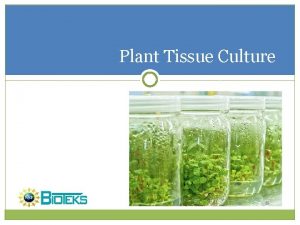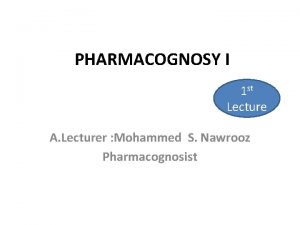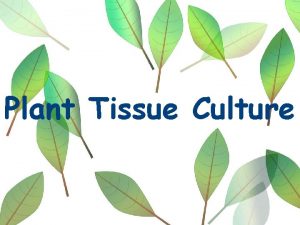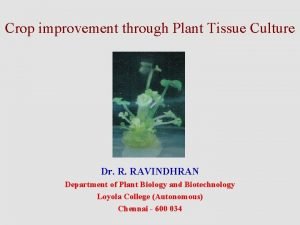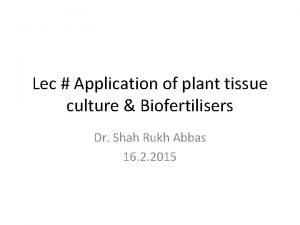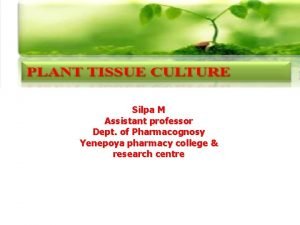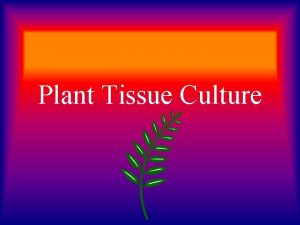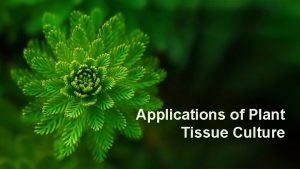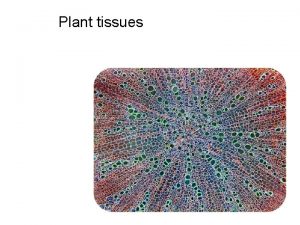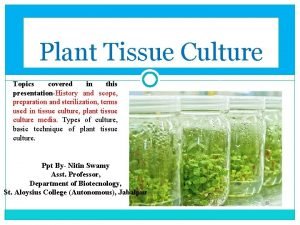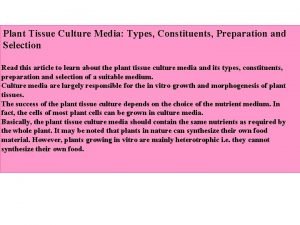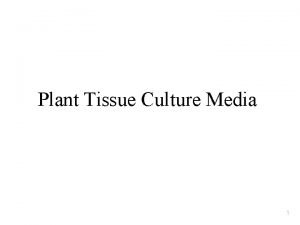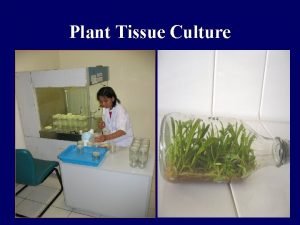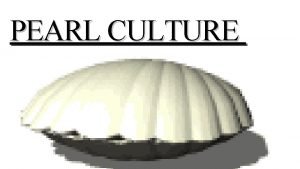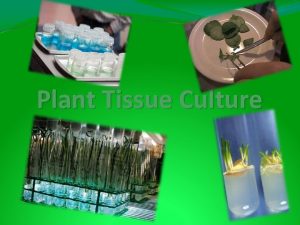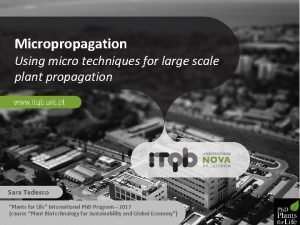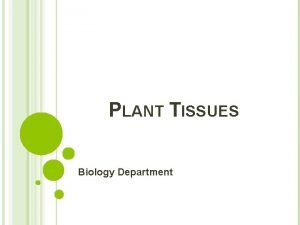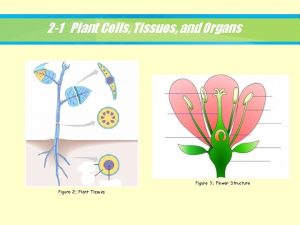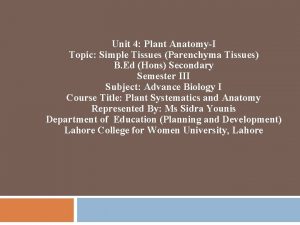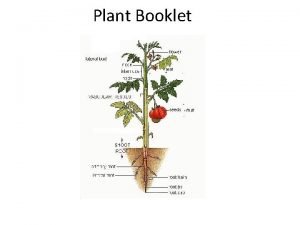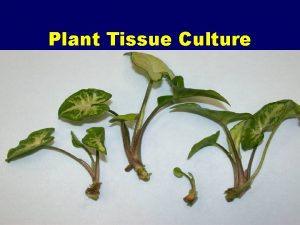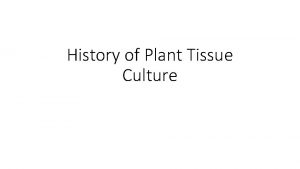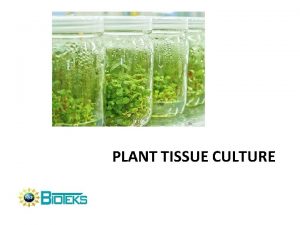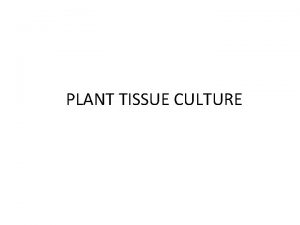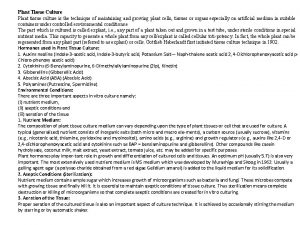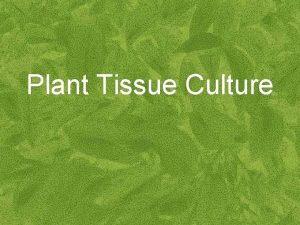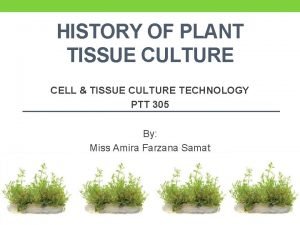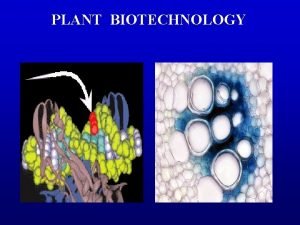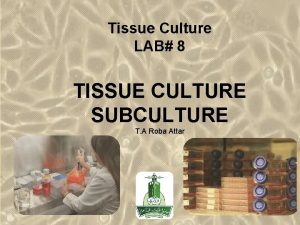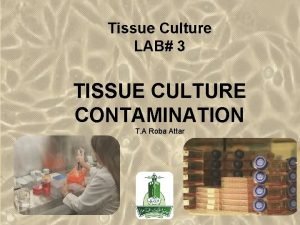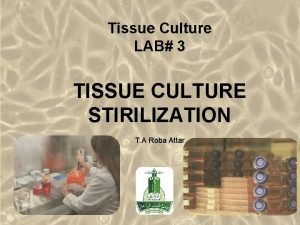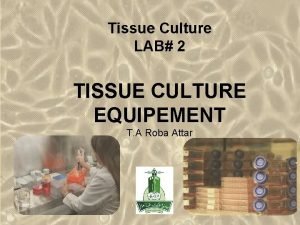PLANT TISSUE CULTURE Plant tissue culture is a


























- Slides: 26

PLANT TISSUE CULTURE

Plant tissue culture is a collection of techniques used to maintain or grow plant cells, tissues or organs under sterile conditions on a nutrient culture medium of known composition. • • Plant tissue culture is widely used to produce clones of a plant in a method known as micropropagation.

PRINCIPLE • Plant tissue culture relies on the fact that many plant cells have the ability to regenerate a whole plant (totipotency). • Single cells, plant cells without cell walls (protoplasts), pieces of leaves, stems or roots can often be used to generate a new plant on culture media given the required nutrients and plant hormones.

Explant � a small piece of the desirable plant is selected. � the selected plant tissue is called as explant. � Generally meristematic tissue or internodal segments of the plant is selected for micropropagation.


The culture environment � Salt Plant cell culture media Mixtures � Organic Substances � Natural Complexes � Inert Supportive Materials � Growth Regulators

Nutrient salts � � � � NH 4 NO 3 KNO 3 Ca. Cl 2 -2 H 2 O Mg. SO 4 -7 H 2 O KH 2 PO 4 Ammonium nitrate Potassium nitrate Calcium chloride (Anhydrous) Magnesium sulfide (Epsom Salts) Potassium hypophosphate Fe. Na. EDTA H 3 BO 3 Mn. SO 4 - 4 H 2 O Zn. SO 4 - 7 H 2 O KI Na 2 Mo. O 4 - 2 H 2 O Cu. SO 4 - 5 H 2 O Co. Cl 2 - H 2 O Fe/Na ethylene-diamine-tetra acetate Boric Acid Manganese sulfate Zinc sulfate Potassium iodide Sodium molybdate Cupric sulfate Cobaltous sulfide

Macronutrient salts � Nitrogen – Influences plant growth rate, essential component in plant nucleic acids (DNA), proteins, chlorophyll, amino acids, and hormones. � Phosphorus – Component in plant nucleic acids, Abundant in meristematic and fast growing tissue, essential in photosynthesis, respiration. � Potassium – Necessary for cell division, meristematic tissue, helps in the pathways for carbohydrate, protein and chlorophyll synthesis.

Macronutrient salts • Calcium - Involved in synthesis of cell walls • Iron – Electron transfer as a component of • and root and leaf development. Participates in translocation of sugars, amino acids, and ties up oxalic acid (toxin). cytochromes Involved in respiration Magnesium – enzyme cofactor, component of chlorophyll, Involved in photosynthetic and respiration systems. Active in uptake of phosphate and translocation of phosphate and starches.

Micronutrient salts • • • Sulfur - structural component of amino acids and enzymes, Involved in formation of nodules and chlorophyll synthesis. Manganese - Enzymes cofactor Molybdenum - Involved in enzymatic reduction of nitrates to ammonia. Assists in conversion of inorganic phosphate to organic form.

Micronutrient salts • • • Zinc – Enzyme cofactor and chlorophyll biosynthesis. Copper - Enzyme cofactor and involved in photosynthetic and respiration systems Boron - Involved in production of growth hormones and chlorophyll. Active in respiration and carbohydrate synthesis.

Organic Compounds �Carbon Sources – Sucrose, sometimes Glucose or Fructose (Plants Need Carbon) � Vitamins – ◦ Adenine – part of RNA and DNA ◦ Inositol – part of the B complex, in phosphate form is part of cell membranes, organelles and is not essential to growth but beneficial ◦ Thiamine – essential as a coenzyme in the citric acid cycle.

Gelling agents � Liquid form – No gelling agent � Solid form - solidified (gelled) Phytagel (1. 5 g/L) Agar (10 -12 g/L)

Natural Complexes � Coconut endosperm � Fish emulsion � Protein hydrolysates � Tomato juice � Yeast extracts � Malt extract � Potato agar

Charcoal � Activated charcoal is used as a detoxifying agent. Detoxifies wastes from plant tissues, impurities ◦ Impurities and absorption quality vary ◦ Concentration normally used is 0. 3 % or lower � Charcoal for tissue culture ◦ acid washed and neutralized ◦ never reuse

Plant growth regulators � auxin Roots � cytokinin Shoots � gibberellin – Cell Enlargement � abscisic acid – Plant stress hormone � ethylene – BAD!

Auxins � Callus formation, rooting of cuttings, and the induction of embryogenesis ◦ ◦ ◦ IAA IBA NAA 2, 4 -D 2, 4, 5 -T Picloram

Cytokinins � -Enhances ◦ ◦ ◦ BAP 2 i. P TDZ Kinetin Zeatin adventitious shoot formation (6 -Benzylaminopurine) (2 -isopentyl adenine) (Thidiazuron

Gibberellin � Not generally used in tissue culture � Tends to suppress root formation and adventitious embryo formation

Abscisic Acid � Primarily a growth inhibitor but enables more normal development of embryos, both zygotic and adventitious

Ethylene � Natural substance produced by tissue cultures at fairly high levels especially when cells are under stress � Enhances senescense � Supresses embryogenesis and development in general

Factors affecting plant tissue culture � Environmental factors (Controlled) ◦ Light intensity (3000 lux) ◦ Photoperiod (16 light -8 dark) ◦ Temperature (20± 2ºC) ◦ Sterile environment

Micropropagation

Applications � The production of exact copies of plants that produce particularly good flowers, fruits, or have other desirable traits. � To quickly produce mature plants. � The production of multiples of plants in the absence of seeds with no dependence of season � The regeneration of whole plants from plant cells that have been genetically modified. � The production of plants in sterile containers that allows them to be moved with greatly reduced chances of transmitting diseases, pests, and pathogens. � The production of plants from seeds that otherwise have very low chances of germinating and growing, i. e. : orchids and Nepenthes � To clear particular plants of viral and other infections and to quickly multiply these plants as 'cleaned stock' for horticulture and agriculture.

Applications It is used widely in the plant sciences, forestry, and in horticulture. Applications include: � The commercial production of plants used as potting, landscape, and florist subjects, which uses meristem and shoot culture to produce large numbers of identical individuals. � To conserve rare or endangered plant species. � A plant breeder may use tissue culture to screen cells rather than plants for advantageous characters, e. g. herbicide resistance. � Large-scale growth of plant cells in liquid culture in bioreactors for production of valuable compounds, like plant-derived secondary metabolites and recombinant proteins used as biopharmaceuticals. � To cross distantly related species by protoplast fusion and regeneration of the novel hybrid.

THANKYOU
 Define explant
Define explant Scope and development of pharmacognosy
Scope and development of pharmacognosy Define plant tissue culture
Define plant tissue culture Plant tissue culture
Plant tissue culture Uses of plant tissue culture
Uses of plant tissue culture Application of plant tissue culture in pharmacognosy
Application of plant tissue culture in pharmacognosy Plant tissue culture terminology
Plant tissue culture terminology Safina plants
Safina plants Laboratory requirements for plant tissue culture ppt
Laboratory requirements for plant tissue culture ppt Callus culture steps
Callus culture steps How is aerolar tissue different than aerenchyma tissue?
How is aerolar tissue different than aerenchyma tissue? Ms media preparation
Ms media preparation Macronutrients and micronutrients in plants
Macronutrients and micronutrients in plants Orchid tissue culture media
Orchid tissue culture media Pearl culture introduction
Pearl culture introduction Techniques of tissue culture
Techniques of tissue culture Micropropagation
Micropropagation Ground tissue system
Ground tissue system Tissue meaning in biology
Tissue meaning in biology Plant tissue and organs
Plant tissue and organs Plant tissue
Plant tissue Which tissue transports water around a plant?
Which tissue transports water around a plant? Plant structure drawing
Plant structure drawing Parenchyma
Parenchyma Plant ground tissue
Plant ground tissue Which tissue transports water around a plant?
Which tissue transports water around a plant? Plants are multicellular eukaryotes
Plants are multicellular eukaryotes
